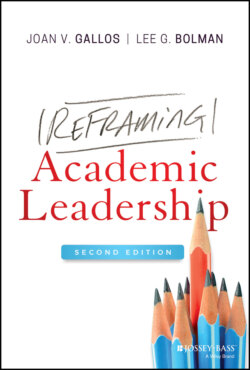Читать книгу Reframing Academic Leadership - Lee G. Bolman - Страница 31
Model II Assumptions
ОглавлениеModel I survives because it enables us to get things done, but at a price that often includes wasted energy, strained relationships, bad decisions, and little or no learning. We continue to pay the price because we don't see our contributions to the bad results – and even if we do, we often don't know a better option. Argyris and Schön (1974) propose Model II as an alternative. The basic precepts of Model II include:
1 Emphasize common goals and mutual interests. Even in a situation as difficult as Sarah's meeting with George, shared goals are possible. They both want to be effective, and neither will benefit from mutual destruction. Creating a shared agenda is a good starting point. Sarah could, for example, have said, “George, you've been in meetings like this before. What do you hope we can accomplish, and how should we proceed to make that happen?”
2 Communicate openly, publicly test assumptions, and be willing to discuss the undiscussables. Sarah dreads the meeting because she believes George will respond negatively to any questions about his performance. Her reasoning puts her in a hole from the beginning because she begins the meeting feeling anxious and fearful. She does not realize that she has built her approach to George around trying to avoid what she suspects is unavoidable – an unpleasant battle with George.Model II suggests that Sarah openly test her assumption with George. She might say, for example, “George, let me tell you what I worry about. If I raise questions about your work, you'll get angry and the meeting will go downhill. Should I be worried about that?” Such directness may seem surprising and risky. But Model II argues that Sarah has little to lose and much to gain. One advantage is that the question subtly calls George's game. It moves the discussion away from terrain where George is prepared for battle to a question that is more difficult for him to answer. It is easy for George to attack when Sarah suggests that his productivity is in decline, but much harder when she asks if he might get annoyed by a discussion of his performance. Even if George does not respond positively to her question, she is following a simple and surprisingly useful precept: “When in doubt, try telling the truth.” That would give George fuller information about her thinking and might enable them to talk about the elephant in the room. It is almost always easier to address something that you can discuss than something you can't.
3 Combine advocacy with inquiry. Advocacy includes statements that communicate what an individual thinks, knows, wants, or feels. Inquiry seeks to learn what others think, know, want, or feel. Successful exchanges need a balance of both. Figure 3.1 presents a simple model of the relationship between advocacy and inquiry and a way to think about the meaning of choices in using both.
Figure 3.1 Advocacy and Inquiry.
Model II emphasizes high advocacy coupled with high inquiry. It asks academic leaders to express openly what they think and feel and to actively seek understanding of others’ thoughts and feelings. The Sarah and George meeting consisted almost entirely of bilateral advocacy. Sarah opened with an attempt at inquiry when she asked George how he saw his performance, but was flummoxed by his response, which Sarah could easily have predicted. She pivoted to advocacy and tried to get George to look at evidence of his declining performance. George tried to persuade Sarah through his attacks that such a conversation was not a good idea. Neither showed any interest in learning about the other's point of view. Sarah never directly asks George for his perspectives on her claims and avoids or rejects almost everything he says. George does largely the same: the only question he asks (“What makes you feel qualified to make such a judgment?”) is an attack rather than a request for information. Sarah saw George as dominating and arrogant without realizing that he could easily feel the same about her.
Model II counsels Sarah to be open with George about her thoughts while testing her assumptions about him and the situation in order to learn about both. This is not easy. Openness carries risks, and it is hard to be effective when you are ambivalent, anxious, or frightened. It gets easier as you become more confident that you can cope with other people's responses and that you have a range of workable options for doing so. How do you build both? Practice. Experiment in low‐risk situations and test out new strategies. Work on strengthening advocacy and inquiry in everyday conversations. Write out and rehearse in advance new responses to situations that are likely to trigger nonproductive reactions. Role‐play with a coach or a trusted colleague. Sarah's ability to handle the difficult conversation with George depends on her confidence in herself and in her interpersonal skills. Beliefs can be self‐fulfilling. If she tells herself that it is too dangerous to be open and that she does not know how to deal with difficult people, she will probably be right. A more optimistic prediction, however, can also be self‐fulfilling.
